In order to visit the municipality of Gáldar, you need to take the Northern Road Carretera del Norte from the capital of the island, Las Palmas de Gran Canaria. This is an easy road running parallel to the north coast of Gran Canaria. To get to Gáldar, you first need to go through the towns of Bañaderos, Quintanilla and San Andrés, and then take the turnoff which is signposted Guía-Gáldar-Agaete. As this road has two lanes in both directions, the 27 kilometres from the capital can be covered in just 20 minutes.
Visitors who wish to get there by public transport need to take bus number 105.
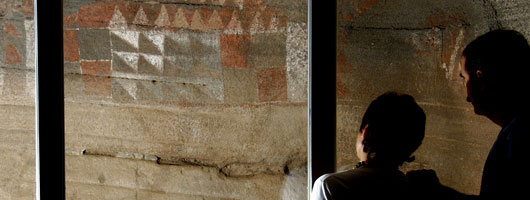
The city of Gáldar, the centre of one of the former kingdoms of the island (Guanartematos), has part of its most distant past on display in the Archaeological Park of la Cueva Pintada, in the centre of the city. This is one of the major cave painting finds in the Atlantic region.
On the coast there is the town and necropolis of La Guancha, at present limited to an area of 24,000 m2, where we can see what the mausoleums of the early inhabitants of the island were like, the dwelling place of guaires and harimaguadas, as well as the burial mounds, including, among other Pre-Hispanic constructions, the largest burial mound preserved in the present day.
The centre of the city, which was given the status of Historic Area in 1981, retains several notable buildings.
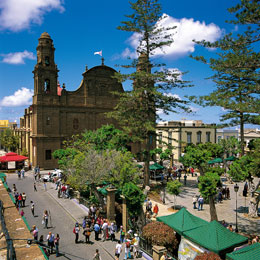
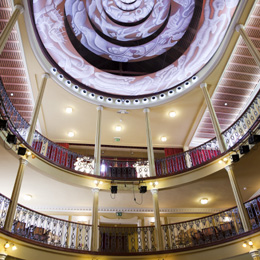
The church Iglesia de Santiago de Gáldar, one of the most beautiful churches in the Canary Islands, serves as a link between the Baroque style and the first examples of neo-classicism of the Archipelago. From the remains of the sixteenth century construction interesting works of art have been preserved in the church, such as the Green Font, where the conquered Canary Islanders were first baptised. Several items of considerable value can be seen inside the church and in the museum next to it, such as paintings, sculptures and works in precious metals.
The Town Hall, built on top of an eighteenth century construction, has outstanding environmental features, with one of the oldest examples of the Drago (dragon tree) in Gran Canaria, documented as early as 1718.
Next to the Town Hall is the Municipal Theatre, built in 1912, which later replaced the older theatre founded by Isabel II.
Another notable element, known as the "Plaza Grande" (Large Square) is one of the best examples of a nineteenth century Canary Islands alameda, including centuries-old examples of Indian Laurel and Araucarias.
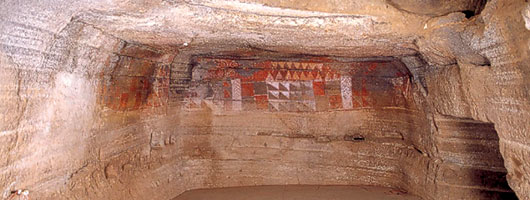
The Museo de Antonio Padrón, a few metres from the square, has over a hundred works of one of the best-known artists of the vanguard movements of the Archipelago in the XX century.
Visitors can also enjoy views of great beauty by going up to the Mountains of Gáldar and Amagro, from where the shaping of the landscape of this historic region can be appreciated. In the interior, a visit to los Pinos de Gáldar (the Gáldar Pines) is an excursion not to be missed, for the grandiose views and the outstanding geological and botanical interest of the surroundings.
While you are passing through, the Historic Centre of Barranco Hondo de Abajo offers the chance to observe one of the most outstanding troglodyte hamlets in the Archipelago, next to which a small ethnographic museum displays some of the main aspects of the more traditional culture of the peaks area of Gran Canaria.
There are many interesting places to bathe along the coast of the municipality. The most outstanding beaches are: playas de los Dos Roques; Punta de Galdar; la Caleta de Arriba; la Caleta de Abajo; la rada del Juncal; la playa de El Agujero, as well as many other shelters and natural swimming pools.
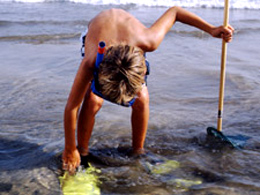
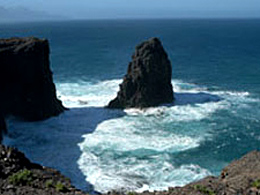
In the very northwest of the island is the rocky outcrop called la Punta de Sardina plus the lighthouse with the same name. Sheltered by this outcrop is Sardina beach and Sardina Port, about five kilometres from the centre of the town of Gáldar. The best sheltered place is Sardina Port, a traditional coastal enclave which has been greatly improved lately due to the building of a new pier. This new construction also provides protection for recreational boats.
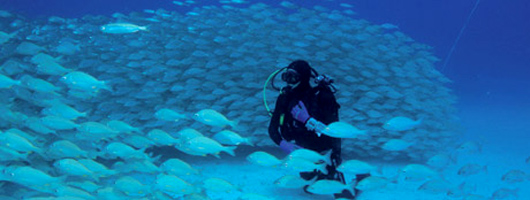
On 20th March 1895, the Sardina pier was declared a place of general interest. Later, it lost its commercial interest and became an active fishing port. This activity continues today. There is a beautiful golden sandy beach about 400 meters long right beside the port. This is an excellent place to bathe as it is more sheltered from the wind and sea currents than the beaches in many other municipalities. The freshly caught fish is offered in attractive, tasty dishes by the numerous bars and restaurants situated close by.
Gáldar has become one of the most populated centres in the northern area of Gran Canaria. The town centre has a large number of shops where all kinds of textile and food products can be bought. At the Municipal Market you can find all kinds of fresh vegetables, as well as fresh produce from the farm and the sea.
It is also possible to buy items of more traditional island handcrafts in Gáldar. There is the making of earthenware crockery in "the old style", in wood-fired clay ovens. Hoya Pineda, one of the main districts of the municipality, is the centre of a large number of craft workshops where items of pottery and ceramics are made, which make the area a major craft centre.
Another product known in Gáldar is the weaving produced on the looms that can be found in most of the rural homes of the municipality. Canary Islands knives are also made by many craftspeople of Gáldar, who invest their craft with different kinds of metal and horn insets in geometrical patterns. The municipality also produces a large part of the island’s wooden crafts.
In Gáldar, as in other municipalities bordering on the north of the island, cheese is one of the tastiest morsels visitors can try. These are sheep milk cheese and those known as "flower cheeses", with a distinctive aroma and flavour given by the use of a thistle flower in the making of the cheese and in the curdling. There are also other cheeses that are just as tasty.
Another highlight is the baby goat and beef dishes that can be tried in many of the restaurants and grills of the town.
In the coastal area of Sardina, fresh fish dishes are another of the municipality’s gastronomic attractions, and these are accompanied by many more exquisite dishes.
Gáldar: Download Tourist Brochure | Map | Podcast
Accommodation: Gáldar
Would you like to learn about the historical town centre of Gáldar?
Join the guided visits with Macaronesia Tours and discover the town’s heritage.